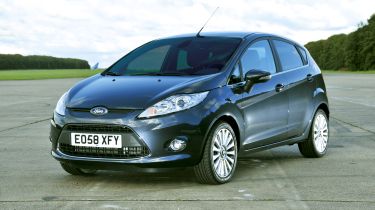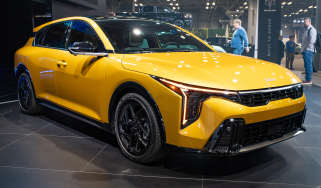Fiesta 1.6 TDCi Titanium 5dr
Top-spec supermini diesel adds a luxury edge
It’s crunch time for the Fiesta. As with any new Ford, it comes withthe weight of expectation of being billed as a future top-seller. Addthe current economic crisis, and the Fiesta couldn’t have arrived at atrickier moment.
So it doesn’t only need to better itspredecessor, it must rewrite the supermini rulebook. Following thesleek looks of the original Verve concept revealed at the 2007Frankfurt Motor Show, the Fiesta makes a real statement in both threeand five-door forms.
Video: watch CarBuyer's video review of the Ford Fiesta
[[{"type":"media","view_mode":"content_narrow","fid":"69693","attributes":{"alt":"","class":"media-image"}}]]
Finished in bright green, our sportythree-door Zetec variant turned heads wherever it went. Without theneed for back doors, the rising waistline flows into the fashionablechunky C-pillar. The shape is reflected in the angular rear lightswhich flank a sharp-looking tailgate.
Glance at the five-door Titanium model, and you can see exactly what awide variety of trims the new Fiesta offers. Mature, grown-up andclassy, it takes on a more understated pose, which is complemented bymulti-spoke wheels. Our duo proves that whether you want to stand outor blend in, there’s a Fiesta to suit.
Inside, we reckon thedesigners have been less successful. Again styling cues from the Verveconcept appear, but some of the shapes and surfaces are convoluted. Thecentre console in particular has taken a leaf out of the Honda Civic’sbook – and appears over-styled as a result.
Used - available now

2022 Nissan
Micra
22,169 milesManualPetrol1.0L
Cash £10,700
2015 Volvo
S60
78,200 milesManualPetrol1.6L
Cash £7,400
2016 Tesla
Model S
78,000 milesAutomaticElectric
Cash £18,999
2019 Nissan
Micra
17,450 milesAutomaticPetrol1.0L
Cash £13,199Trim quality alsocomes up short elsewhere in the cabin. You don’t have to look far tofind hard plastics, while details such as the interior door handlestake a step back from the previous model. However, even though it’svirtually identical in size to the old-shape model, the new Fiesta ismuch more practical. Legroom is on a par with rivals, no matter howmany doors you choose.
Unfortunately, Ford has applied anunimaginative approach to cabin versatility. The 295-litre boot growsto 979 litres with the seats down, yet don’t expect any folding tricks.The seatbase is fixed and the backs flop down on top, leaving plenty ofuseful space, but no flat load floor. You do get the same capacity inboth three and five-door variants, though. Practicality isn’tsignificantly bettered by any one rival; we just think Ford could havedone more. Head for the open road, and any voices of dissent are soonsilenced. The Fiesta does for superminis what the original Focus didfor compact family hatchbacks – exceeds all expectations.
As soonas you set off, every point of contact, from the pedals to thegearstick, feels perfectly placed, weighted and responsive. There’splenty of adjustment in the steering wheel to cater for differentdriving positions, too.
Our three-door test model was powered byFord’s 95bhp 1.4-litre petrol unit. It’s carried over from the previousFiesta with only a mild retune, but it still delivers adequateperformance. Only the high-revving Mazda 2 was quicker, although theFord makes up for its sedate
pace with polished handling dynamics. The three-door Fiesta serves uphot hatch agility as standard, and arguably offers more fun than a MINICooper. Even small movements of the steering wheel result in accurateand controlled cornering at almost any speed.
One gripe is thatbuyers are not only asked to pay £300 extra for stability control, butonce fitted, the system can’t be switched off. This won’t be a problemmost of the time, although the safety system is very intrusive whenyou’re pushing hard through bends. Climb aboard the five-door Fiesta,start the engine, and you will hear the familiar clatter of Ford’s89bhp 1.6-litre diesel. The oil-burner doesn’t quite score so highlyfor its powertrain as the petrol car. The clutch, gearbox and enginesimply don’t gel in such a cohesive way.
Performance is more thanadequate, however, with the sprint from 0-60mph taking 12.3 seconds.In-gear punch is more than a match for diesel-powered rivals, too. Ifyou’re going to fill your Fiesta from the black pump, chances are youwill be tackling several thousand motorway miles per year. Anyone whothinks choosing a supermini as a long-distance cruiser is madness hadbetter think again. The Fiesta devours journeys with the kind of ridecomfort, refinement and economy that puts cars from the class above toshame. Over a test route that included everything from high-speed lapsof a private test track to dual carriageway traffic, the five-doorFiesta managed exactly 47mpg.
For a full breakdown of the exactfinances, turn to Page 52. Yet with prices starting from £8,695 forbase cars, and rising to £13,695 for the flagship, there is a Fiestafor everyone. Ford has a created a hugely capable new supermini in boththree and five-door form. It’s not the cheapest contender on the market– but is it the best? Read on to find out!
Details
Price: £13,695
Model tested: Fiesta 1.6 TDCi Titanium 5dr
WHY: Ford hopes this top-spec Titanium five-door will draw buyers from the class above.
Economy
When it comes to prices, there’s not much between our five-door trio. But the Ford is the best investment, with a 42 per cent residual – over the same period, the Renault and Vauxhall retain 35 and 34 per cent. The Ford will also cost less to maintain, although the Corsa has longer service intervals – 12,500 to 20,000 miles – which will appeal to high-mile drivers.
Environment
If you want cheap road tax, this is the model to go for. The Fiesta has the lowest CO2 output of all our five-doors. A 110g/km figure places it in band B, so a year’s disc costs £35.







